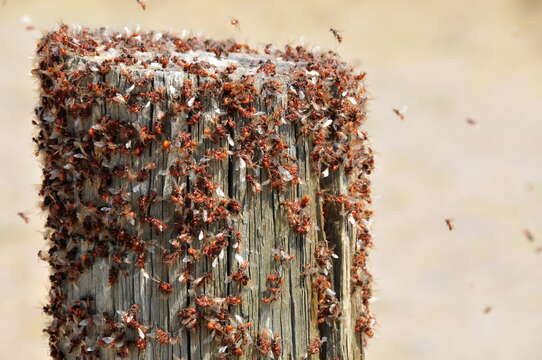Western Harvester Ant Swarm on Seedskadee National Wildlife Refuge (28951059731)

Description:
Description: "Creepy but Cool" as one Refuge visitor described it. For a few days each summer, western harvester ants are very noticeable. Each colony produces winged alates. These "flying ants" gather in mating swarms. The males die soon after mating and the females attempt to found new colonies. Only a small number of queens will be successful. Successfully established colonies may persist for over 20 years! Colonies usually contain a single queen who is responsible for producing the eggs. It has been reported that the mating swarms occur one to two days after a significant rain. That matches what was observed this year. Epic thunderstorm on Sunday with the ant swarms on Monday and Tuesday. The majority of a colony is made up of workers. They do most of the work in a mature colony, including collecting pollen and seeds from the plants directly and gathering seeds from the ground. They also gather insects and store the food for winters when food becomes scarce. Viewed from Google Earth, Western harvester ant colonies are one of the most notable features of the sage-steppe on and around Seedskadee NWR. Photo: Tom Koerner/USFWS. Date: 2 August 2016, 11:49. Source: Western Harvester Ant Swarm on Seedskadee National Wildlife Refuge. Author: USFWS Mountain-Prairie.
Included On The Following Pages:
- Life (creatures)
- Cellular (cellular organisms)
- Eukaryota (eukaryotes)
- Opisthokonta (opisthokonts)
- Metazoa (Animal)
- Bilateria
- Protostomia (protostomes)
- Ecdysozoa (ecdysozoans)
- Arthropoda (arthropods)
- Pancrustacea
- Hexapoda (hexapods)
- Insecta (insects)
- Pterygota (winged insects)
- Neoptera (neopteran)
- Endopterygota (endopterygotes)
- Hymenoptera (wasps, bees, and ants)
- Apocrita (wasp)
- Aculeata
- Vespoidea (Yellowjackets and Hornets, Paper Wasps; Potter, Mason and Pollen Wasps and allies)
- Formicidae (ants)
- Pogonomyrmex (Harvester Ants)
- Pogonomyrmex occidentalis (Western Harvester Ant)
This image is not featured in any collections.
Source Information
- license
- cc-by-3.0
- copyright
- USFWS Mountain Prairie|sourceurl=https://flickr.com/photos/51986662@N05/28951059731%7Carchive=https://web.archive.org/web/20190114102356/https://www.flickr.com/photos/51986662@N05/28951059731/%7Creviewdate=2018-05-17 09:06:50|reviewlicense=cc-by-2.0|reviewer=FlickreviewR 2
- creator
- USFWS Mountain Prairie|sourceurl=https://flickr.com/photos/51986662@N05/28951059731%7Carchive=https://web.archive.org/web/20190114102356/https://www.flickr.com/photos/51986662@N05/28951059731/%7Creviewdate=2018-05-17 09:06:50|reviewlicense=cc-by-2.0|reviewer=FlickreviewR 2
- source
- Flickr user ID usfwsmtnprairie
- original
- original media file
- visit source
- partner site
- Wikimedia Commons
- ID


